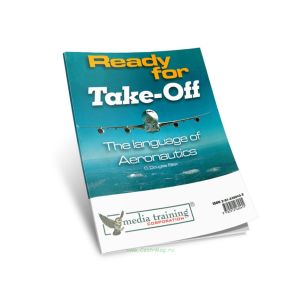Развернуть ▼
Ready for Take-Off is an introduction to standard
aeronautical English and is intended for use by students and adults involved or interested in aircraft and aircraft manufacturing. In preparing the book many hard choices had to be made as to which materials to include and which to exclude. For space considerations it was not possible to include every type of aircraft flown today. Nor was it imaginable to give attention to every aspect of aircraft manufacturing and assembly. Ready for Take-Off concerns itself with civil aircraft and, except for a few passages devoted to light aircraft and their systems, the large jet passenger airliners. Even these had to be narrowed down dramatically to the production of the two major players in today’s aviation skies: America’s Boeing and Europe’s Airbus Industrie, although I have tried not to overlook other significant aircraft types such as Lockheed, McDonnell Douglas and Concorde.
Ready for Take-off is not meant to be a course in aeronautics or in aviation, but to present the vocabulary and language forms used in English when we need to talk about aircraft structures, components, their functions, and design. Students having learned the basic facts of wing structure and design as it exists, say, on an Airbus A320 should have little difficulty in talking about a wing on a Boeing or Tupolev. The terms lift, thrust, and drag apply to a B747 as well as to a Cessna or Beechcraft.
As its title suggests, Ready for Take-Off focuses on the manufacture, assembly, and preparation (including cabin layout and configuration) leading up to flight. For this reason little or no attention is paid to in-flight navigation including avionics, weather forecasting, and radio communications, areas which generally do not concern the engineers and technicians working in the earlier phases of aircraft construction and assembly.
Ready for Take-Off is the outgrowth of more than seven years of working with people from all areas of the aircraft industry in Toulouse, France. During these years much of the material contained in this book was used by hundreds of technicians, engineers, secretaries, assistants, maintenance managers and their staff, and even by people in commercial or contract departments. I was even lucky to design an entire training program for pilots, technicians and engineers preparing for the day when the “Super Guppy” transporter used to ferry aircraft parts around Europe was to be replaced by the now familiar “Beluga” transporter. This textbook is offered to everybody who, like all these people, are highly qualified in their individual fields, but for whom English is a hurdle which is often difficult to get over. It is also designed for students preparing for a career in any area linked to aeronautics.
Contents
section 1: Basic Aircraft Structure and the Principles of Flight
Part 1: On the outside: Basic aircraft structures
1.2. Simple descriptions
1.3. The principle of flight
1.4. Stability
1.5. Aerodynamics
1.6. How big is big?
1.7. Very big!
Grammar checklist #1
1.8. Practice Comparing and Contrasting
PART 2: On the Inside: Cabins, cockpits and configurations
1.9. Cabin configuration
Grammar checklist #2
Section 2: Aircraft Structures in More Detail
2.1. The fuselage
2.2. Describing wing structure
Grammar checklist Grammar checklist #3
Grammar checklist #4
2.3. Oil systems: an example from light aircraft
2.4. An example of a typical cooling system
2.5. Hydraulic systems
2.6. Landing gear
2.7. Cabin pressurization and air conditioning
2.8. Water supply and drainage
2.9. Supplementary section: design parameters
2.10. Special Presentation Section
2.11. Special Presentation Section
SECTION 3: Powerplants for the aircraft
3.1. How does a propeller provide thrust?
3.2. How does a jet engine provide thrust?
Grammar checklist #5
3.3. Fan jets
3.4. How is engine power measured?
3.5. Engine manufacturers take steps to remedy deficiencies
3.6. Dealing with older, noisier aircraft
3.7. The Concorde: sole supersonic passenger transporter
Section 4: Inside the Cockpit
4.1. Historical perspectives
4.2. The Boeing 111 cockpit: a brief description
4.3. Boeing aims high
4.4. Flight deck configuration: A320
4.5. Avionics
Grammar checklist #6
Section 5: Errors, Misjudgments, Failures and Technical Problems
Part 1: Delays in assembly and other problems
5.1. Model-practice: stored а/с status
5.2. Model-practice: assembly halt
5.3. Model-practice: fuselage damage on A/C
5.4. Model-practice: flap attachment damage
5.5. Model-practice: rudder artificial feel unit
5.6. Dealing with problems: communication applications
Grammar checklist #7
Part 2: More serious incidents and accidents
5.7. Pilot error
Grammar checklist #8
5.8. Pilot Error Responsible for Crash?
Grammar checklist #9
5.9. The explosion of TWA Flight 800
5.10. A true story: A Narrowly-Averted Disaster?

